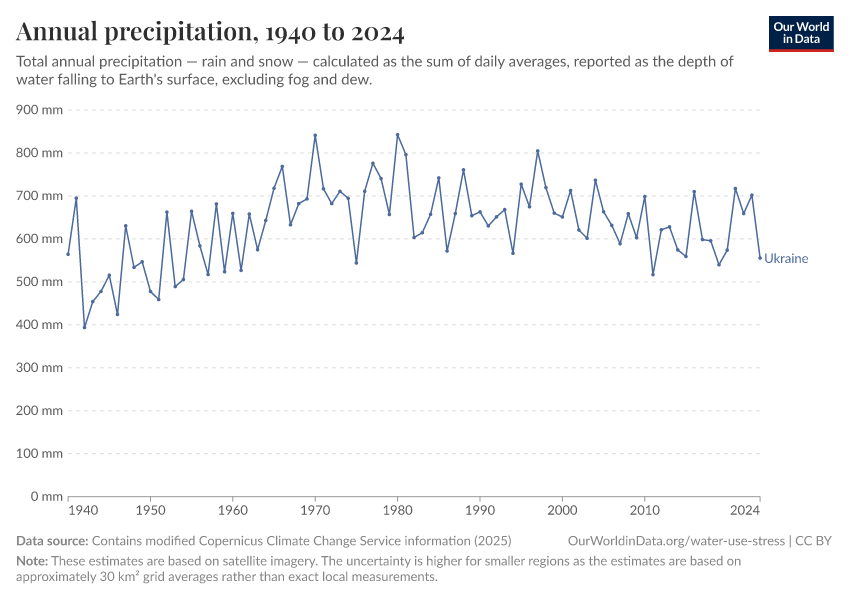Annual precipitation

What you should know about this indicator
What you should know about this indicator
Sources and processing
This data is based on the following sources
How we process data at Our World in Data
All data and visualizations on Our World in Data rely on data sourced from one or several original data providers. Preparing this original data involves several processing steps. Depending on the data, this can include standardizing country names and world region definitions, converting units, calculating derived indicators such as per capita measures, as well as adding or adapting metadata such as the name or the description given to an indicator.
At the link below you can find a detailed description of the structure of our data pipeline, including links to all the code used to prepare data across Our World in Data.
Notes on our processing step for this indicator
- Initially, the dataset is provided with specific coordinates in terms of longitude and latitude. To tailor this data to each country, we use geographical boundaries as defined by the World Bank. The method involves trimming the precipitation dataset to match the exact geographical shape of each country. To correct for potential distortions caused by projecting the Earth's curved surface onto a flat map, we apply a latitude-based weighting. This step is essential for maintaining accuracy, particularly in high-latitude regions where distortion is more pronounced. The result of this process is a latitude-weighted average precipitation for each nation.
- It’s important to note, however, that due to the resolution constraints of the Copernicus dataset, this methodology might not be as effective for countries with very small landmasses. In such cases, the process may not yield reliable data.
- The derived precipitation for each country is calculated based on administrative borders, encompassing all land surface types within these areas. As a result, precipitation over oceans and seas is not included in these averages, keeping the data focused on terrestrial environments.
- Global precipitation averages and anomalies, however, are calculated over both land and ocean surfaces.
- The precipitation anomaly is calculated by comparing the average precipitation of a specific time period (e.g., a particular year or month) to the average surface precipitation of the same period from 1991 to 2020.
- When calculating anomalies for each country, the total precipitation of a given year or month is compared to the 1991-2020 average precipitation for that specific country.
- The reason for using the 1991-2020 period as the reference mean is that it is the standard reference period used by our data source, the Copernicus Climate Change Service. This period is also adopted by the UK Met Office. This approach ensures consistency in identifying climate variations over time.
Reuse this work
- All data produced by third-party providers and made available by Our World in Data are subject to the license terms from the original providers. Our work would not be possible without the data providers we rely on, so we ask you to always cite them appropriately (see below). This is crucial to allow data providers to continue doing their work, enhancing, maintaining and updating valuable data.
- All data, visualizations, and code produced by Our World in Data are completely open access under the Creative Commons BY license. You have the permission to use, distribute, and reproduce these in any medium, provided the source and authors are credited.
Citations
How to cite this page
To cite this page overall, including any descriptions, FAQs or explanations of the data authored by Our World in Data, please use the following citation:
“Data Page: Annual precipitation”, part of the following publication: Hannah Ritchie, Pablo Rosado, and Veronika Samborska (2024) - “Climate Change”. Data adapted from Contains modified Copernicus Climate Change Service information. Retrieved from https://archive.ourworldindata.org/20251027-111021/grapher/average-precipitation-per-year.html [online resource] (archived on October 27, 2025).How to cite this data
In-line citationIf you have limited space (e.g. in data visualizations), you can use this abbreviated in-line citation:
Contains modified Copernicus Climate Change Service information (2025) – with major processing by Our World in DataFull citation
Contains modified Copernicus Climate Change Service information (2025) – with major processing by Our World in Data. “Annual precipitation” [dataset]. Contains modified Copernicus Climate Change Service information, “ERA5 monthly averaged data on single levels from 1940 to present 2” [original data]. Retrieved December 29, 2025 from https://archive.ourworldindata.org/20251027-111021/grapher/average-precipitation-per-year.html (archived on October 27, 2025).